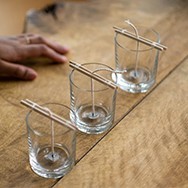-
MenuBack
-
Candle-making
-
-
Plant-based Waxes
-
-
Plant-based Waxes
-
-
-
Blended Waxes
-
-
-
-
Mineral & Animal waxes
-
-
Formulated Waxes
-
-
Additives
-
-
Our Additives
-
-
-
MenuBack
-
Candle-making
-
-
Plant-based Waxes
-
-
Plant-based Waxes
-
-
-
Blended Waxes
-
-
-
-
Mineral & Animal waxes
-
-
Formulated Waxes
-
-
Additives
-
-
Our Additives
-
-
Common Mistakes in Candle Making and How to Avoid Them
Candle Making: Common Mistakes and How to Avoid Them
Candle making is an art that may seem simple but requires precision and expertise to achieve a high-quality final product.
Whether you're an experienced artisan or a passionate beginner, it's easy to make mistakes that affect the performance and appearance of your creations.
Here is a list of the most common mistakes, along with practical solutions to avoid them.
Choosing the Wrong Wick
One of the most frequent mistakes is selecting an unsuitable wick for your candle. A poorly chosen wick can lead to uneven burning, tunneling around the wick, or a flame that extinguishes too easily.
How to Avoid This Mistake:
- Consider the diameter of your candle: A wider candle requires a thicker wick to ensure even burning, while a smaller candle needs a thinner wick.
- Test different wicks: The best way to determine the ideal wick is through experimentation. Make several versions of your candle using different wick sizes and observe how they burn.
- Take the type of wax into account: Some waxes, like soy wax, may require thicker wicks compared to more traditional waxes like paraffin.
Overheating the Wax
Overheating wax is a common mistake that can alter its properties and affect the appearance of your candle. Excessively hot wax can also impact fragrance adhesion or cause cracks as it cools.
How to Avoid This Mistake:
- Use a thermometer: Monitor the temperature of your wax with a candle-specific thermometer. Each type of wax has an optimal melting temperature, usually provided by the manufacturer.
- Melt wax over low heat: Use a double boiler for better temperature control. Avoid direct heat sources that can quickly raise the wax temperature.
- Add fragrance and additives at the right temperature: If the wax is too hot when adding fragrance, essential oils may evaporate, reducing scent throw. Always check the recommended temperature for each type of wax and fragrance.
Using the Wrong Fragrance-to-Wax Ratio
An incorrect balance between fragrance and wax can result in candles that have little to no scent or, conversely, candles that release too much fragrance, leading to burning issues.
How to Avoid This Mistake:
- Follow the recommended fragrance load: Most wax manufacturers suggest a fragrance ratio between 6% and 10%, depending on the wax’s ability to retain scent. Too much fragrance can make the wax unstable and difficult to solidify.
- Accurately weigh your ingredients: Avoid approximations. Invest in a precision scale to ensure an exact fragrance-to-wax ratio.
- Mix thoroughly: Once the fragrance is added, stir well to ensure even distribution. This prevents scent from concentrating in certain areas of the candle.
Not Allowing Wax to Cool Properly
The cooling process is just as important as melting the wax. If a candle cools too quickly, it can develop cracks, sinkholes around the wick, or an uneven surface.
How to Avoid This Mistake:
- Let candles cool slowly: Avoid placing them in cold environments, such as a refrigerator. Allow them to cool at room temperature for a smooth surface.
- Cover your candles: If you live in a drafty area, cover your candles while they cool to prevent cracks or surface imperfections.
Candle making is a journey of discovery and refinement. By avoiding these common mistakes and applying practical solutions, you’ll increase your chances of creating high-quality candles that are beautiful and ready to sell or display.
Remember, every step matters—from selecting the right ingredients to monitoring temperature carefully. With patience and practice, you'll master the art of candle making!


